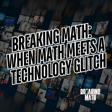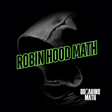Become a Creator today!Start creating today - Share your story with the world!
Start for free
00:00:00
00:00:01

5: Language of the Universe (Relationship Between Physics and Math)
1948. A flash, followed by an explosion. Made possible by months of mathematical computation, the splitting of the atom was hailed as a triumph of both science and mathematics. Mathematics is seen by many as a way of quantifying experiments. But is that always the case? There are cases where it seems as though mathematics itself has made predictions about the universe and vice versa. So how are these predictions made? And what can we learn about both physics and math by examining the way in which these topics intermingle?
---
Support this podcast: https://anchor.fm/breakingmathpodcast/support
Transcript
The Triumph of Splitting the Atom
00:00:00
Speaker
1948. A flash followed by an explosion, made possible by months of mathematical computation, the splitting of the atom
00:00:09
Speaker
was hailed as a triumph of both science and mathematics. Mathematics is seen by many as a way of quantifying experiments. But is that always the case? There are cases where it seems as though mathematics itself has made predictions about the universe, and vice versa. So how are these predictions made, and what can we learn about both physics and mathematics by examining the way in which these topics intermingle?
Introduction of Hosts and Guests
00:00:30
Speaker
All of this and more on this episode of Breaking Math, Episode 5, Language of the Universe.
00:00:42
Speaker
I'm Jonathan Baca. And I'm Gabrielle Hesh. And with us, we have... Charlie Shipley, freelance journalist. Amy Lynn, mathematics teacher. And we have a new guest on this week. Can you introduce yourself? Hi, I'm Dr.
Math and Physics: Prediction and Theme
00:00:55
Speaker
Leondra Bushiran. I am a lecturer in physics here at the University of New Mexico. And what brought you into physics?
00:01:02
Speaker
So when I was a little kid, I was really interested in math and I wanted to be a mathematician. But the further I studied in math, I decided I wanted to do something a little more useful with it. So I'm sorry. I'm sorry. Are you telling me math is not useful? It's very useful when applied to science. We're going to fight. And I was reading a little bit through your thesis and you do a lot of stuff about x-rays. Do you want to talk at all about your research?
00:01:31
Speaker
Yeah, so basically my favorite topic in physics to talk about is radiation. And I talk about this a lot in my introductory physics classes. Radiation is something that people have this sense that it's inherently bad, it's inherently evil, but that's just a form of radiation called ionizing radiation. Your light bulbs radiate, the human body radiates heat, and those are forms of radiation that are not harmful.
00:01:59
Speaker
Ionizing radiation can cause some biological damage, but many people don't really understand it fully. And you said earlier that you liked how math was applied to physics, and that's a lot we're going to be talking about on the show today.
Are Math and Physics Separate or Intertwined?
00:02:12
Speaker
There's a concept called the unreasonable effectiveness of mathematics in the natural sciences. Gabriel, do you want to kind of talk about what that is?
00:02:19
Speaker
Yes, absolutely. In fact, as you said earlier, the same title. Excuse me, I don't mean to interrupt you, but before we go any further, it sounds like you're saying to me, as my understanding has always been incorrect, apparently, that math and physics are not one and the same. They're not two sides of the same coin. Is that correct?
00:02:36
Speaker
That's actually, I'm really glad you brought that up because there's several ways that I could address that question. No, no, of course, you have a mathematics department at UNM, you've got a physics department at UNM, and if you ask any pure mathematician, they'd vehemently say absolutely not. Pure math is not the same as applied math, and also applied math is not the same as physics. Yet, how can we, for a listener who's not familiar with it, how would we say that physics and math are very closely related?
00:03:05
Speaker
And Gabriel actually introduced me to this quote.
00:03:28
Speaker
So the quote you just read reminds me of another quote from Galileo who said, the great book of nature is written in mathematical symbols. And this quote really ties together the importance of mathematics in describing physics and describing physical phenomena in the world around us.
Aristotle's Influence and Missteps
00:03:47
Speaker
And of course, one of the things that we're going to talk about today is how a lot of times pure math finds its way into physics and vice versa. I mean, we're going to be talking about anything from conic sections to complex numbers. And before we get into that, we are going to talk a little bit about Aristotle and some of his crazy beliefs.
00:04:09
Speaker
Oh gosh, sure. I just wanted to mention real quick, Aristotle is so fascinating. What we've actually spoken about on our very first episode was how much of a following Aristotle had, how many people looked up to him. And he's very, very key for this episode because clearly humanity is very good at coming up with stories that are not reflective of reality, at least as far as... But are convincing.
00:04:34
Speaker
Yes, yes, but are very convincing. So I'm really glad that we're including him in this episode as a contrast. Yes, and Amy, could you please read the quote by Aristotle?
00:04:44
Speaker
Among natural bodies, some have and some have not life. And by life, we mean the faculties of self-nourishment, self-growth, and self-decay. Thus, every natural body partaking of life may be regarded as an essential existence, but then it is an existence only in combination. And since the organism is such a combination, being possessed of life, it cannot be the vital principle. Therefore, it follows that the vital principle must be in essence as being the form of a natural body holding life in potentiality,
00:05:11
Speaker
but essence is a reality. The vital principle is the original reality of a natural body endowed with potential life. This, however, is to be understood only of a body which may be organized. Thus the parts even of plants are organs, but they are organs that are altogether simple, as the leaf which is the covering of the pericarp, the pericarp of the fruit. If then there be any general formula for every kind of vital principle, it is the primary reality of an organism.
00:05:38
Speaker
Of course, this quote goes into a lot of Aristotelian beliefs, the belief that living material was completely different than dead material, which wasn't debunked until the late 1800s with the production of Urea.
From Aristotle to the Synthesis of Urea
00:05:53
Speaker
Oh, that's right. Actually, that's a great story because that even includes chemistry, where organic chemistry or the chemistry of life was completely separate from inorganic chemistry, even though we still have those two classes in most colleges. Can you tell the story a bit about the discovery of urea just briefly?
00:06:11
Speaker
Oh yeah, it was the first organic chemical found. It's found, I believe, in urine. And yeah, it was thought that it could not be synthesized from inorganic chemicals, but it turned out that it could. I don't remember the process by which this was done.
00:06:27
Speaker
Why is that the first one you would produce? Of all the things in the world, why would you produce urine first? Because they had to find out if they could, and they didn't ask themselves whether or not they should. That's a common theme inside. Quick flashback to our first episode. What was the other Aristotle idea that was completely wrong, but completely accepted? Wasn't it that all the nerves... Yeah, so there was that Aristotle believed wholeheartedly and convinced everyone else that all of the nerves originated from the heart when we know that they come from the brain.
00:06:57
Speaker
Wow. Yeah. And then he also believed
Archimedes' Early Natural Laws
00:06:59
Speaker
in, you know, there were five elements, earth, wind, I'm sorry, I'm not... And fire. Yeah. I'm not doing Captain Planet here, but yeah, five elements, earth, water, wind, water, and I think something else. Quintessence. Quintessence, right, right. Yeah. So he was a philosopher and a lot of people believed him. Wow.
00:07:15
Speaker
Now, another person from ancient Greece, a much more rigorous person, was Archimedes of Syracuse. He strongly developed the principle of levers, and this is one of the very first natural laws. Liana, would you like to talk a little bit about simple machines and how they work?
00:07:32
Speaker
Yeah, so simple machines in physics, the primary ones are going to be the lever, the pulley, the inclined plane. And these are all great examples of instruments that we use to teach introductory physics students how some of the laws work. For instance, an inclined plane, which you could also think of as a ramp.
00:07:54
Speaker
It's something that we use to help us elevate things. It makes it easier to bring something to a greater height as opposed to just lifting it straight up. The lever is another type of machine that we use to give ourselves what we call a mechanical advantage. And it seems like all the things that you're saying about simple machines involve the transformation of force. Absolutely. Force is one of the most fundamental foundations behind physics and describing how motion works.
00:08:23
Speaker
Of course, the formula for a lever is the distance times the mass is equal on both sides of the place that it rests. And there's actually a quote by Archimedes of Syracuse, give me a long enough lever in a place to rest it and I can move the world.
00:08:39
Speaker
And this shows one of the central properties of a natural law. When you take it to the infinite, you get bizarre and unintuitive results.
Conic Sections in Physics
00:08:47
Speaker
Just imagine lifting up a blue whale using a giant seesaw that has longer on one side than the other. This mathematical principle of using levers to lift things is actually a description of torque.
00:09:00
Speaker
And torque is when we use forces to rotate something. And it wasn't until really hundreds of years later that we had a good description of torque, what it was, how it causes rotations. So it's interesting that just even so early we were able to come up with a mathematical formula describing the ratio on sides of a lever that applied to a physics concept we didn't really even know about.
00:09:24
Speaker
Leandra, could it be said that torque is the only force that has its own tool dedicated to it? This sounds like a sarcastic question, but there's not a lever wrench or an inclined plane hammer.
00:09:42
Speaker
But there is a torque wrench. Sure. And I think that gets back to this idea of a lever arm. The longer something is, the easier it's going to be to rotate something. That's actually a really fun way of introducing physics to kids. That's what we did in sixth grade science.
00:10:05
Speaker
Now moving on a little bit, from ratios and levers, we have the concept of conic sections. Imagine a cone. If you slice it across, you'll get a circle. But what happens when you slice it at an angle? If it's a shallow angle, you'll get an ellipse. But what happens if you slice it straight up and down? In this case, you'll get what's called a hyperbola. And if you slice it at the same angle as the cone itself, you'll get what's called a parabola. But what does this have to do with physics?
Astronomy's Impact on Physics
00:10:27
Speaker
Now, of course, Connick's sections were first described rigorously by Apollonius, which was translated by the poet Omar Khayyam, who's best known, of course, for 1001 Nights. And a familiarity that a lot of people will have with that is a flashlight or a lamp. If you shine a flashlight at the wall, you get a circle, you shine it at an angle, you get an oval, and you shine it up and down, and you get the hyperbola shape.
00:10:50
Speaker
Oh yeah, good call, good call. So a lot of early physics discoveries were really driven by astronomy. Mankind has long had a fascination with looking up into the sky, looking at the stars, looking at the planets and asking the question, why do they move? Why did they behave the way that they do? And this is a really great adaptation of conic sections.
00:11:13
Speaker
So one thing that builds on a little bit what you're saying is that planets don't move like stars. Stars move around the North Pole. They go in circles. But stars seem to move back and forth. They'll squiggle across the sky. And this is why it took so long for people to figure out. Now before we continue, Amy, have you taught conic sections?
00:11:36
Speaker
To some extent, for the most part in high school, we talk about parabolas. That's generally as far as we get. We don't generally get too hyperbolas or even ellipses. And circles are difficult because they don't technically define a function. And in algebra 2, especially, we mostly stick to functions. But especially in high school physics,
00:11:54
Speaker
We talk about parabolas a lot, that if you imagine throwing an object, its path through the air is a parabola. And so finding that peak where it stops moving for just a moment, vertically in space, that is an important piece in physics and that's something that we can calculate algebraically and which I make them do and they hate it because it's word problems. One thing that you said is that objects, when you throw them through the air, trace the path of a parabola, correct?
Kepler and Tycho Brahe's Contributions
00:12:20
Speaker
Yes.
00:12:20
Speaker
However, one interesting thing about that is that it's only an approximation, correct? It's not going to be a perfect parabola. There's going to be forces acting on it that would ... If you account for the surface of the Earth, it traces out a very, very long ellipse. Is it an ellipse, an infinite ellipse, basically a parabola?
00:12:42
Speaker
Essentially. But if you cut off a side of the ellipse, you get a section of a parabola. So all planets move around a star in the shape of an ellipse, and the shape is also taken by other astronomical objects such as comets. So comets have very, very large what we call eccentricity, which means that the ellipse is very, very stretched out.
00:13:03
Speaker
So even if a comet only comes around once every 150 years, it's still moving in the shape of an ellipse. Just the sun is very, very close to the edge of one of that ellipsis. So before we talk about Kepler, it'd be criminal to talk about Kepler without first mentioning his boss, who is a guy named Tycho Brahe. So Tycho Brahe was an interesting astronomer, physicist. He actually lost his nose in a duel. Oh, he wasn't about a formula?
00:13:32
Speaker
Yes, over a math formula. So I guess in some sense he was like a modern day Tyrion Lannister. So he lost his nose. He had a pet moose from many accounts as well as a prognosticating dwarf. What is a prognosticating dwarf?
00:13:47
Speaker
a fortune-telling dwarf who could see the future, according to some accounts of Tycho Brahe. Tycho took very, very accurate measurements of the stars. In his day, the idea of the Sun being at the center of the solar system was not well accepted.
00:14:05
Speaker
Tycho took accurate enough measurements that he actually could tell that the planets orbited around the sun, but religiously, he couldn't make this claim. He had his own model of the universe, which was called the geoheliocentric model.
00:14:22
Speaker
So in his model, all of the planets went around the Sun, but the Sun still went around the Earth. And he held this belief for many years. He took Kepler under his purview as a student.
00:14:38
Speaker
and it wasn't until Taiko Brahe passed away at a dinner actually where he was entertaining some royalty. He had a very full bladder and it was considered rude to get up so he continued sitting and his bladder burst. He later died from an infection as the result of this incident.
00:14:59
Speaker
So he had a glamorous death. Oh yes, very. At the
Fourier's Transformation of Understanding
00:15:02
Speaker
hands of his prognosticating dwarf. I think I would have just peed myself. It wasn't until after his death that Kepler was able to really get his hands on the data and formulate his laws and really bring mankind through to the full heliocentric model.
00:15:18
Speaker
That's extremely interesting. His measurement, as I recall, you mentioned Kepler a little bit, and one interesting thing about Kepler is that in trying to find the shape that the planets went around the sun in, he tried everything before ellipses, basically. He tried heart shapes, he tried, like, rounded star shapes, and he just tried the ellipse out of frustration, apparently, because that's a lot of calculation to do. I mean, Tycho, like you said, had such amazing instruments that
00:15:44
Speaker
I mean, he had to be able to buy them with his extreme wealth. He owned about 10% of the wealth in the country at the time. My question is, did the dwarf inherit that massive wealth after Tycho Brahe passed away? Did he? I couldn't tell you. History leaves out the knowledge of Tycho Brahe's dwarf.
00:16:01
Speaker
Tycho Brahe's dwarf is my punk man officially. Now the Kepler's laws of course are governing planetary motion and these are empirical laws meaning that they are laws generated from massive amounts of data instead of from a philosophical concept. It's of course a gradient. Kepler's laws are that all planets orbit in ellipses
00:16:23
Speaker
that the arm that goes from the sun to the planet sweeps out an equal area in an equal amount of time and that the semi-major axis is cube is proportional to the square of the period of rotation. And using these, people like Newton were able to develop things like calculus. Have these concepts carried into mathematical tools and things like that? Like would it be fair to say that a compass operates in an ellipsis or a parabola?
00:16:50
Speaker
So one of the primary examples we use in high school to explain why, and I believe it's a paraboloid, correct me if I'm wrong, that a dish, like a radio dish or the direct TV dish, anything that is dish shaped is a parabolic shape. And then that receiver, the transmitter, it goes to a point which is called a directrix. And so that is something that is a direct application of something we do in real life that is parabolic.
00:17:14
Speaker
It also extends into literature in H.G. Wells' novel, The War of the Worlds. The tripods operated with parabolic mirrors and that's how they generated their heat ray.
00:17:25
Speaker
So I find it interesting that, so Kepler, you said that it is very, he had lots of data and had, how did you put it? Empirical laws? Empirical, yes. So Kepler's approach was empirical, meaning that he had lots and lots of data and then he made a conclusion, drew a conclusion from that data. That is very much my perception of the physicist approach, or the engineering approach, whereas mathematicians are like, but what's the formula? What's the law?
00:17:51
Speaker
And so I find it interesting when sometimes the math is preceded by the science, that we then search for that beauty, that perfect proof, once we know that it's real.
00:18:02
Speaker
And we have a wonderful example of that in Fourier sequences. There are times when physics teaches us about mathematics. Joseph Fourier was a 19th century mathematician who was studying how the heat is distributed on a circular
Sound Waves and the Doppler Effect
00:18:14
Speaker
ring. The math itself is too involved to go into, but the gist of it is this. Any periodic function, meaning a function that repeats itself, can be represented as an infinite sum of sines and cosines. To put it another way, any sound that repeats can be recreated with an infinite amount of tuning forks, and approximated with many.
00:18:30
Speaker
Now Fourier sequences obviously come up a little bit when you're talking about planetary orbits. You have what's called cycles and epicycles. That's when you try to trace out the path of a star of a planet going across the sky. But Fourier was the person who really put this into mathematical terms, but it was not accepted by everybody, especially not the Academy for many, many years. And the reason why is this.
00:18:55
Speaker
You can have a function that jumps, meaning that it goes from one point to another in no time at all, made by continuous functions. And we're going to play a quick sound example of that. We're going to create a buzzing sound using only pure tones. So explain to us what's happening in that sound.
00:19:20
Speaker
Now what's happening in that sound is we want to create a buzzing sound. And to do that, we take all the constituent components of that buzzing. We have a wave that has a width of, let's say the first wave is a wave that has a width of one. We take one of those, then we add to it a third of a wave, but the wave is a third as big. Then you do a fifth of a wave as fifth as big, and you add it together and you get this buzzing sound. You get a discontinuous function.
00:19:50
Speaker
So the analogy I'm thinking of is when you want to create black, but you don't have black, you just mix all the other colors.
00:19:56
Speaker
I mean, the best you could do, I think, with that is gray. Dark gray. So, Jonathan, I wanted to say, the way you explained it, I thought it was actually quite well. I was following quite well in my head. However, that may be in part because of my studies in electrical engineering, and I've seen the analogy before. I did want to say that we will have, on our Facebook page as well as hopefully on our website, an actual, what do you call it? It's a gif or a gif. We can argue about that. It's a gif, right?
00:20:20
Speaker
Oh yeah, we'll have a GIF and also we'll have a live demo and you can find this at breakingmathpodcast.com slash applets.html or on our Facebook page at facebook.com slash breakingmathpodcast.
00:20:32
Speaker
So I think we should describe at least a little bit what a sinusoidal wave is. So we mentioned the word sine and cosine. Yes. So a sinusoidal wave or a sine function is something that I'm trying to imagine how to picture it. It's a wave. So it's a perfect wave, however. So if you're picturing a wave on an ocean, it's inconsistent. But think about drawing a line that goes up and then curves back down and then curves back up.
00:20:56
Speaker
One way that you can see something that approximates a sine wave is if you have a coil or a slinky and you stretch it out real big. Wow, yeah, excellent example. So if you were to trace the movement of the object at the bottom of the slinky maybe? Or no, I'm picturing something else. Oh no, that's a sine wave obviously in time.
00:21:13
Speaker
But I'm saying if you stretch out the slinky and you just look at the shape that it makes, it'll be a squiggly line, it'll look like a snake, and that's a sine wave too. It approximates a sine wave. I believe that was an experiment done by Dr. Egon Spangler when he was a child. Who's Dr. Egon Spangler? Dr. Egon Spangler. From Ghostbusters. He had part of a slinky. Egon. But he straightened it.
00:21:35
Speaker
So one of the really cool applications of Fourier transforms is actually the human ear in combination with the brain. So our ears are only capable of picking up one sound at a time, but we know from our everyday experience that you can hear multiple conversations at the same time. You can hear several different sounds.
00:21:54
Speaker
What's happening is that that single wave that's reaching your ear, your brain takes it and pulls it apart into the separate component waves. So what your brain is doing is called an inverse Fourier transform. It's taking something that it hears and breaking it up into the pieces that must be combining to make it whole.
00:22:13
Speaker
We actually use that principle in episode two, wreaking chaos to transmit a fractal through the human ear.
00:22:26
Speaker
So the Doppler effect, what that means, that's when you, for instance, you hear a siren going by, and before the siren has passed you, it sounds very high pitched. After it passes you, it sounds very low pitched. So it sounds something like. So the concept of the, what was it, inverse Fourier? Inverse Fourier transform. Inverse Fourier transform. So that's not necessarily directly or indirectly related to the Doppler effect.
00:22:56
Speaker
They're both related to waves, but the Doppler effect is more going to be a shift in the frequency than a superposition of waves being added together. Now, a sound, though, that is being affected by the Doppler effect, how does that shift look on the graph?
Relativity and Noether's Theorem
00:23:13
Speaker
Shift on the graph is going to be a shift in the periodicity of the wave, which basically means how wide it's going to look. So when the wave is pushed together, that's going to be a higher frequency, it's going to sound like a higher pitch.
00:23:27
Speaker
So if we use the slinky analogy again basically if you stretched out a slinky but one portion of it was squashed together that's the higher frequency part and then it gets to the lower frequency part for the shift, correct? Exactly. I wanted to say just generally speaking and for the sake of this podcast since we're talking about worldviews with mathematics and with physics it seems that with astronomy
00:23:49
Speaker
It started off, as Amy said earlier, empirically, with writing down data based on observations and measurements. This is a major, major thing. And actually, astronomy even started off, the ancient Greeks knew about it, and so did the Chinese, you know, with the idea of watching the stars and making charts goes way back. It was only once that the data was compiled enough that patterns began to emerge that then we had a gradual shifting of our worldview.
00:24:15
Speaker
Oh yeah, and a famous Chinese discovery that dealt with that is that comet tails always point away from the sun because that's how they're formed. Before we get too far away from waves, one of my favorite examples of science before math is the kind of invention of radio waves or of radio that was, the name is escaping me. Gugliurmo Marconi. Marconi. Gugliurmo Marconi.
00:24:38
Speaker
that he was obsessive compulsive, that the man worked tirelessly changing things and adjusting things and teeny tiny little experiments to finally get his radio to work. And then he didn't found any of his data. He just, he made it bigger so that the radio waves could go far, right? He did not found anything that he did on mathematics or on any really in engineering. He was not popular in his time because of that. He just finagled with it until he got it right.
00:25:07
Speaker
So I have a set of jokes which referring to this difference between empirical and quantitative. So how many theoretical physicists does it take to change a light bulb? How many? It takes two. One to hold the light bulb in place and one to rotate space around it. So the second joke says how many experimental physicists does it take to change a light bulb?
00:25:29
Speaker
2.05? It's actually 12. One of them to take the to actually do it and the other 11 to help co-author the paper. I think the invention of the light bulb was a similar story though right that he went through what thousands of different versions before he finally figured out how to produce light. I mean his lackey is dead. What was the biggest point of contention or the biggest hurdle was the design of the filament?
00:25:54
Speaker
Oh yeah, they tried bamboo and stuff and bamboo glowed but it broke immediately. One of the things about mathematics and physics is that when mathematics comes before physics or physics comes before mathematics, it's usually a singular relationship. However, we're going to discuss a situation where entire groups of physical theories are generated by a mathematical formula.
00:26:17
Speaker
Emmy Nather was a mathematician who revolutionized many fields. One of her discoveries is known as Nather's Theorem. Nather's Theorem states that any continuous symmetry generates a corresponding conservation law. But before we can discuss what that means, we're going to have to discuss what symmetry is in physics. So Leandra, can you explain to us what a symmetry is in physics?
00:26:37
Speaker
So some real life examples of symmetries would be the wings of a butterfly. One wing looks very similar to the other. It's just going to be a mirror image. So symmetries are something that looks the same if you rotate an object, if you flip that object, if you're looking at it a different way.
00:26:55
Speaker
Of course another type of symmetry is symmetry in time. For example, if I can do an experiment today and do the same one tomorrow, that's a time experiment. You also have symmetries in space, where if I do an experiment here and I do an experiment somewhere else, we have the same thing. And we have a quote from a dialogue concerning the two chief world systems.
00:27:14
Speaker
Despite much thinking about it, I have not been able to find any difference. So it seems to me, I have found, that there can be no difference. Hence, I think it vain to seek one further. For consider, motion, insofar as it is, and acts as motion, to that extent exists relatively to things that lack it. And among things which all share equally in any motion, it does not act, as if it did not exist.
Symmetries and Conservation Laws
00:27:42
Speaker
Thus, the goods with which a ship is laden, leaving Venice, pass by Corfu, by Crete, by Cyprus, and go to Aleppo. Venice, Corfu, Crete, etc., stand still and do not move with the ship, but as to the sacks, boxes, and bundles with which the boat is laden, and with respect to the ship itself, the motion from Venice to Syria is as nothing, and in no way alters their relation among themselves.
00:28:12
Speaker
This is so because it is common to all of them and all share equally in it. If, from the cargo in the ship, a sack were shifted from a chest one single inch, this alone would be more of a movement for it than the 2,000 mile journey made by all of them together.
00:28:30
Speaker
Now what Noether's theory is, is that if you have a continuous symmetry, like a symmetry in time or like a symmetry in space like Galileo just described, you have a corresponding conservation law. Now Gabriel, when have you dealt with conservation laws in engineering?
00:28:46
Speaker
Oh, I think this actually is one that's addressed for almost any field in science. Conservation of matter, conservation of energy, you know, with conservation of matter. Now, again, as an engineer, I actually think of it more of when I taught it, because then I had the concept right in front of me.
00:29:04
Speaker
Conservation of matter, of course, is you cannot create nor destroy matter. You can only change its state from a gas to a solid to a liquid. Those are three of the states of matter. Conservation of energy is similar. You cannot create nor destroy energy. You can only transfer it.
00:29:23
Speaker
the really exciting part, the really exciting idea introduced by Einstein, which we will get to, is that you can turn matter into pure energy and vice versa, but we'll get to that later on. Can you conserve force? No, there is no principle of conservation of force.
00:29:40
Speaker
And what's interesting about Nather's theorem is that it's dependent on the system involved. For example, if you're in space and you do an experiment where you're facing one direction, you could rotate and do the same experiment, and what that means is that rotational momentum is conserved. However, if you do the same experiment on Earth upright and to the side, you won't get the same results because you have a gravitational field.
00:30:07
Speaker
Therefore in this system, rotational momentum is not conserved. That's one of the brilliant things about Nather's theorem. It's been used everywhere throughout mechanics and quantum mechanics and beyond. For example, quantum chromodynamics uses this all the time.
00:30:21
Speaker
So can I get a nutshell of that whole quote of what this kind of concept is? Because I think I get it. Well, what he's saying is, if you're on an airplane, you could throw a ball, and it feels like you're just throwing the ball because your momentum is, because your velocity is the same. You can't tell what speed you're going in a car. It's a Galilean relativity, which is a type of symmetry. Well, it's not a type of symmetry, but it's dependent on symmetries.
00:30:47
Speaker
It's kind of like we're throttling through space in this exact moment on Earth, but because we're so small and Earth is so big, we don't notice that movement. Almost the same thing because on Earth, of course, we have the centrifugal force of us going around the sun or centripetal. I mean, I guess we experience it as centrifugal because we are in our coordinate system. It was very deep, Amy.
00:31:09
Speaker
So another great example of this Galilean relativity of motion would be to ask this question. So a hawk is flying horizontally and it drops a mouse. What shape does the motion of the mouse take? Why? It's a straight line, obviously. I know.
00:31:27
Speaker
Yes, Amy. That was a terrible physics joke. It's a parabola. So this question depends who you ask. If you ask an observer who's standing on the ground, they'd say the mouse makes a parabola. But if you ask the hawk, the hawk would say it made a straight line and the mouse moves straight down beneath it. We were both right, Amy. It's a matter of the hawk's perspective, right?
00:31:48
Speaker
Yes, so that's the principle behind Galilean relativity, is that things can look different depending on your reference frame, but still describe the same motion.
00:31:57
Speaker
So to recap Nather's theorem, what it is, is that when you have a symmetry, it generates a corresponding conservation law. So when you have a symmetry in time, meaning that I could do the same experiment today and tomorrow and get the same result, you have conservation of energy. If I could do the same experiment at one angle and another angle, it means that there's conservation of rotational momentum.
00:32:19
Speaker
And when I could do an experiment here and five meters to my right and get the same result, that means that momentum is conserved.
00:32:28
Speaker
You know, when you first introduced the idea of Nathan's theorem, I actually was quite fascinated by it. When I was researching this episode, it was late at night, I realized that I was mixing up conservation and symmetry. I was thinking of the equal sign, you know, the whole E equals mc squared or F equals ma. But no, that's not quite what symmetry is. But what Nathan's theorem suggests, as you just said, is they are intricately related. They are weaved together, which is really, really cool. Is that right?
00:32:57
Speaker
Yeah, it's one of the most beautiful theorems in all of physics in my opinion. Wow. So then, and then not to go off too much on a tangent here, but really when you think of any of the conservation laws, including the relationship between matter and energy and space, there's also a symmetry that that can describe as well.
Symmetry Breaking and Cosmic Imbalance
00:33:16
Speaker
Oh yeah, the theorem goes both ways. And what's beautiful about the theorem is that if you find any symmetry in physics, including in new fields, there's already a corresponding physical law.
00:33:29
Speaker
Again, I don't want to confuse the two because conservation is not symmetry. Conservation is not symmetry. However, all symmetries have conservation laws. So if we're doing new physics and we find even physics like quantum chromodynamics or something bizarre like that, when you find a symmetry,
00:33:51
Speaker
you know that something is conserved. That's what's beautiful about this is that it's a machine that generates physical laws. So to stop here just for a moment, I'm still stuck on the idea of symmetry being visual. But what you're saying is that not only is it visual as in the concept of the butterfly, but it's also a condition of momentum, of movement, of forces, of
00:34:16
Speaker
Let's say you're ordering breakfast, and I give you two pieces of bacon instead of one. If you're just as happy with that breakfast, there's a symmetry involved. I'm going to eat more than two pieces of bacon. All right, finally, you find pieces of bacon. I'm just saying that right now. Let's not put a number on the bacon, because there's going to be a lot of bacon. No, is the amount of bacon conserved? Because then there's a corresponding symmetry.
00:34:37
Speaker
So I can't eat five pieces of bacon and have less than five pieces of bacon of energy in my body is what you're saying. There has to be a symmetry between the bacon consumed and the energy that I derive from the bacon.
00:34:50
Speaker
What you're saying is true if the same amount of bacon today and tomorrow will feed you the same amount. Oh, and I'm sorry, it would be the energy of the bacon is conserved, not the symmetry. However, the symmetry there is that today heats five pieces of bacon and feels full. Tomorrow it eats five pieces of bacon and feels full. It gets the same amount of energy today and tomorrow from the bacon. So then we have the symmetry and the conservation law.
00:35:13
Speaker
Okay, cool, yes, and the conservation of the energy from the bacon. Yes, the energy in the bacon is conserved when it is in your belly. Seeing as a mathematician, I just want to see the formulas, because y'all are talking about bacon. I just want to see the bacon. Right, well there's that too. That's the difference between the- Let's just get right down to it and have some bacon.
00:35:29
Speaker
Okay, now, again, speaking of conservation laws and symmetry in the universe, there's another fascinating thing from a physics standpoint, and I don't know what the mathematical relevance of this would be, but breaking symmetry. Oh, yeah. Leandra, can you explain to us breaking symmetry, an example of that?
00:35:51
Speaker
Sure, and a good example would be you're walking into a fancy banquet dinner and you sit down at the table and the places have all been set in front of you. So you have your plates, you have your forks, your knives, and you have your cups. And in front of you, there's two cups, one to the left and one to the right. And you don't know which is your glass.
00:36:13
Speaker
If you're the first person sitting down at that table, you can choose either one you want. But if you're not the first person sitting down at the table, if you take a glass from the other side, someone at the table is going to be left without a glass and someone at the table is going to have two. So the first person at the table is breaking the symmetry. They're choosing, I'm going to take the glass on the right, and they're, in essence, choosing for everyone else at the table that they also have to take the glass on their right.
00:36:42
Speaker
That's really interesting, because I know that one example of symmetry breaking is in the distribution of matter itself, a consequence of this. We had the Big Bang. It started at a point. For some reason, we have things like chairs, and the universe isn't just a giant cloud of gas. It's a random object to choose. The Big Bang happened. We have chairs now. So the Big Bang happened, and it started at a point, and now we have chairs.
00:37:11
Speaker
I use chairs a lot in physics. I mean, who knew, right? I mean, wow. Can I, may I give the symmetry breaking example with the Big Bang? Oh yeah, definitely. Okay, thank you. Mine is a little different than Jonathan's. Okay, you know, mine does start with the Big Bang.
00:37:29
Speaker
So in physics and as an appreciator of art, I look for examples of physics everywhere, you know, as we've said for the umpteenth time, butterfly wings, of course. Another example of symmetry in the universe shortly after the Big Bang actually is the formation of both matter and antimatter.
00:37:49
Speaker
just in brief for our listeners who are not familiar. So we know that matter is made of atoms that have a negatively charged electron in the orbit. It's got positively charged protons in the middle, as well as neutrons. Antimatter is just matter with the opposite charge. The electrons are positively charged. They're called positrons. The protons are negatively charged, and I don't know that they have another name.
00:38:14
Speaker
They're called antiprotons. Very good, just antiprotons. Creative. Very creative. Now, in the beginning of the universe with the formation of matter, there were equal amounts, or rather there should have been equal amounts of matter and antimatter. When matter and antimatter form, when they come together they quickly annihilate and release energy.
00:38:37
Speaker
So we know that with our mathematical models of the universe, after the Big Bang, all of the matter and all of the antimatter should have annihilated very, very shortly. There was a break in symmetry and there's a lot more matter than there is antimatter and nobody knows
Neutron Stars and Black Holes
00:38:55
Speaker
why. We're thankful because that's why we're all here today.
00:38:58
Speaker
But there should be an equivalent amount of antimatter somewhere in the universe that someday may annihilate when it comes into contact with us. So that's a useful and very fortunate breaking of symmetry. That's terrifying. It is. Oh, that's one of them. That's absolutely what I was just going to say. That is a terrifying break of symmetry. Now, for the last part of the podcast, we'd just like to give you some interesting information about physics itself. Now, Gabriel, you said you wanted to talk about neutron stars.
00:39:25
Speaker
Yeah, actually, when we were planning this episode about mathematics and physics, I actually was reminded briefly of a lot of my favorite concepts in physics. Real quickly, I'd like to allude back to an old sci-fi movie from the late 1990s. You all know about the movie The Matrix. The Matrix was praised as a great philosophical movie that's also a real big Hollywood movie.
00:39:50
Speaker
There's a scene in the movie where there's a woman named Trinity, and she is talking to the character played by Keanu Reeves. And in this scene, Trinity is talking to Keanu Reeves about a question that continually gnaws at him. And she basically says, you know, it's the question that drives us. It's like a splinter in your mind.
00:40:11
Speaker
Very much in the physical sciences, very much in physics, there are these unanswered questions that just gnaw at us, that just gnaw at me, and I'm driven to find an answer to them, and there's a couple of questions involving specifically neutron stars and black holes that I have no answer to that continuously drive me.
00:40:33
Speaker
Now, real quickly, so if I can give the history of, or if I can give a quick description of both neutron stars and then their relationship to black holes, hopefully that may convey why I'm so fascinated by them. Please do. Okay, so for those of us who have taken a basic astronomy class in college, or if we've watched enough of the Science Channel, we should know the basic life cycle of a star.
00:40:56
Speaker
When you've got a star, after many, many years, it will run out of fuel and it will stop burning. A star of the size of, say, our sun, when it stops burning, it will collapse into a smaller version of itself because it still has all the gravity, it just doesn't have the energy. So it's got these, it's got some compact atoms of helium and hydrogen, probably mostly hydrogen, and it makes what's called a white dwarf.
00:41:20
Speaker
Well, there's a lot of gravity. We basically, we know from elementary school science that the bigger an object is, the more gravity it has. We know that if you were to be on Jupiter, the gravity would be much greater than it is on Earth. Same with the Sun. So, we all know from elementary school that the more massive an object is, the more gravity. Now, that's distinct from size.
00:41:44
Speaker
that's as much stuff that's compact in a given space. That's very important for this entire story. So our Sun, that's a lot of stuff. And a white dwarf is all of the mass of the Sun that's compact into a much smaller volume. But it has the same gravity that the Sun had. Now, before I go further and describe what a neutron star is, I'm wondering if we can discuss the basic model of an atom.
00:42:12
Speaker
Sure, so an atom consists of a very small nucleus which contains all the positive protons as well as the neutral neutrons and we have the negatively charged electrons orbiting about the center of the atom. In between there's actually nothing. So what feels like solid matter is mostly made up of empty space. It's just when you get down on that level the interactions between those charges are so strong that you push on a table
00:42:40
Speaker
the electrons in your hand repel the electrons in the atoms of the table and it feels as if it's a solid. Okay. Wow. So that's very important to consider in how a neutron star is unique. Now with a white dwarf, as I was talking about earlier, basically all of the hydrogen atoms and the other atoms of helium and other constituent particles are compact together. With a neutron star, there's so much mass and such a little volume
00:43:09
Speaker
that the gravity pulls the electrons into the nuclei of the atoms altogether, just smashes them together. So all you have are neutrons. A neutron star does not have the space between the nucleus and the electron cloud. It's nothing but a big clump of neutrons. The density of neutron stars, let's talk about a few of the elements of the density. So it's all the mass of several suns squashed together into the size of about Manhattan.
00:43:39
Speaker
Now, one of the interesting things about neutron stars is that they're so dense that a teaspoon of a neutron star would weigh as much as the Empire State Building. And the reason why this gravitational collapse does not collapse further is because of the Pauli exclusion principle. What this states is that two neutrons cannot occupy the same quantum state, and that actually creates pressure.
00:44:00
Speaker
Here's what I like about the math behind neutron stars. As Jonathan brought up the saving element of neutron stars, what they can't break through has to deal with the Pauli exclusion principle. That means that there is a limit to the damage, to the gravity that a neutron star will experience. I was happy about that until I read about even more massive objects dying. Jonathan, you want to take us there?
00:44:30
Speaker
Sure, if you pass what's called the Chandu Sakhar limit, which I think is roughly a little more than three sun's worth, it might be eight, a mass of enough objects, several times the weight of our own sun, what you get is a force so great that it even overcomes the Pauli exclusion principle. This is an unbelievable amount of gravity.
00:44:52
Speaker
And when that happens, you have what's called a black hole. Black holes are exotic objects. They have the property, for example, that if you dropped a clock into it, the clock would seem to slow down and then stop as it reached the surface of the black hole. But the clock would see the universe racing past it. Like in the opening of the Twilight Zone.
00:45:13
Speaker
As another size comparison, while the Earth itself would never spontaneously form a black hole, if you were able to compress the entire mass of the Earth down into one millimeter size, you would also get a black hole. And yeah, black holes can be made theoretically out of any size, and they're amazing objects. It's incredible to me that there's basically these pock marks in the universe that are essentially, please correct me if I'm wrong, endless voids.
00:45:43
Speaker
That's pretty much what they are. One way to kind of think about a black hole, the way that I enjoy thinking about a black hole is stretching the fabric of space time just continuously, just keeps falling in. It's not totally mathematically accurate, but no mathematical model is.
00:45:59
Speaker
I mean, is it like inverted mass that it's so dense that it's collapsed on itself? So the way I like to think about the universe is, you know those coin funnels where you stick a coin into the top and it spins around until it goes into the bottom? Yeah. So the universe is like a set of these. So every mass, every planet, every moon, every star is basically one of these coin funnels. And the bigger the mass, the deeper it gets.
00:46:25
Speaker
So a black hole is a coin funnel that is so deep it's ripped into this fabric of space time. But that's where the scariness comes because it's like the grand question is, well, then what, you know? So the answer to that is, you know, most coin funnels, for instance, the Earth, you could reach in and you could pick up the coin and take it out. A black hole is one where you could never reach into it. The escape velocity, which means how fast you have to be going to get away from it, is faster than the speed
Conclusion: The Unending Dance of Math and Physics
00:46:55
Speaker
of light.
00:46:55
Speaker
Just that concept can keep me awake at night, that black holes that you can never reach into and get the coin. I want there to be a limit. I want there to be something that they can't, I don't know. Am I alone here? Am I the only one who's creeped out by black holes? Oh no, it's terrifying.
00:47:13
Speaker
We've explored everything from the unreasonable effectiveness of mathematics and the natural sciences, Aristotle's misguided theories, conic sections on gravity, Fourier sequences, symmetries, and even some theoretical physics. We will only learn more about our world as mathematics is further refined, and we will learn more about the platonic ideal of math as more physics is discovered. One thing seems certain, however. Physics and math will be indefinitely intertwined.
00:47:38
Speaker
I'm Jonathan. I'm Gabriel. And this has been Breaking Math. Join us on Breaking Math. Charlie, do you have anything you'd like to plug? No. Amy, anything that you'd like to plug? No, I don't have anything nice to say, so I'm not going to say anything at all. And Leandra, anything that you'd like to plug? You should consider being a physics major.
00:48:00
Speaker
And of course you could find our website at breakingmathpodcast.com or you could find us on Facebook at Breaking Math Podcast. Breaking Math Podcast is made possible by KUNM Studios.



















